May 2013
By Tad Bradley
Chobe National Park, Botswana
The northern sector of Chobe has a reputation as crowded with self-drivers and budget lodges around Kasane. While this is mostly deserved, the park, especially the eastern edge along the Chobe River, offers a great safari value and with far less travel-time and expense as the Okavango Delta. Sure, the Delta is the ideal spot should your travelers have the time, budget and adventurous spirit. But for those with limited time and budget constraints, Chobe is a good choice, especially as a part of a Chobe-Vic Falls-Hwange itinerary. Here are three lodging options for the safari-goer in the Chobe region, each distinct in its experience and offering unique benefits.
Click on the images below for more information on the Chobe Lodges I visited.
Ngoma Safari Lodge
Located just outside the northwestern (Ngoma) entrance of the park in the Chobe Forest Reserve, Ngoma sits high on a ridge with unobstructed views of Chobe River and the Caprivi flood plain. It is not hyperbole to say it has a jaw-dropping view. The Lodge offers eight relatively spacious thatched suites each with the same magnificent view of the river below (two are slightly larger and can be made into triples). Complete with an outdoor shower, private plunge pool, AC and a very comfortable bed, the rooms are nice but it’s the view that really makes this place special. The main Lodge is an open-air, dark-wood, thatched roof kind of job, with several cascading levels of decks and a small pool. Below in the river plain is a waterhole which is conveniently illuminated at night, so game viewing (esp. plains game) is excellent 24-hours a day (should you find yourself star-gazing late in the evening or with an insatiable appetite for safari). Because of the location just outside the park, night-drives and bush walks are available in the surrounding conservancy (this is community-owned land, leased to several lodges) adjacent to the park. Neither is an option in the park itself. Game drives enter on the western side of the park, avoiding the overcrowding on the eastern side near Kasane. All-day game drives into Chobe National Park allow guests to explore deeper into this huge park, finding more game (including big cats – several groups had fantastic lion sightings while I was there) and really avoid the overcrowding that exists. I had time for one afternoon game drive within the concession and I was very impressed with the guiding and the game. At sundowners, we spent time with a large herd of elephants right along the river and watched jumpy group of buffalo, zebra and giraffe stampede across the flood plain. For exclusivity, honeymooners and those that want a variety of safari activities beyond the traditional game drive and river cruise, this is a good choice. Ngoma is part of the Zimbabwe-based Africa Albida group which owns Victoria Falls Safari Lodge among others.
Chobe Game Lodge
The following morning, I headed into the national park to the only lodge located inside, Chobe Game Lodge. This is a very well-run affair by Botswana safari-veterans Desert and Delta Safaris. Often combined in a circuit with D&D’s Okavango properties, CGL has allure on its own by virtue of its location in the park. Originally built in the 70’s by the Southern Sun group, the lodge is styled in a sort of Moorish motif, which sounds odd but is actually quite well-done. It is a large (for Botswana) with 47 relatively small rooms (except for the four suites each with a massive private balcony with a plunge pool). The bathrooms are quite small and cramped with a bathtub/shower combo, not great for your mobility challenged traveler. They are planning to expand the bathrooms within the year, adding walk-in showers and around 10 meters in space, which will solve the space issue completely. The size of the lodge, depending on the traveler, could be a turn-off or turn-on after the intimacy and wilds of the Delta camps. If you are selling the circuit, I’d tend to sell the itinerary starting at Chobe and heading down into the Delta. That said, an argument could certainly be made for the reverse. CGL has several other unique features beyond its location in the park. It is one of the few (and I think, the first) safari lodges to have woman guides. It also has its own dock for Chobe river cruises and several large decks connected by raised wood walkways, sitting on the river’s edge. Desert and Delta is a leader in environmental and social sustainability. The lodge uses solar power in the suites from 6am-6pm (daylight hours), uses treated grey water for maintaining the grassy areas in front of the lodge, employs a staff-doctor (who also happens to be quite a handy carpenter as well) offering regular free medical services for all staff, and promotes staff from within the company’s ranks. Game-drives are all within the park and the location offers a more exclusive experience, away from the more crowded sectors of the park near the entrances. This is a great lodge for kids of all ages. They offer a specific family suite that sleeps four (a queen and two twins in separate rooms) and have a nice pool but the lodge is not fenced, so keep that in mind for younger kids.
Chobe Chilwero
One of Sanctuary Retreats finest properties (IMO), Chobe Chilwero is just a stone’s throw from the gate of the National Park and is located on a bluff overlooking the Chobe River. The 15 extremely spacious thatched cottages are spread out on each side of the main lodge fronting a large lawn area shaded by trees. These are huge rooms (some are larger than others) with even bigger bathrooms, including both an indoor and outdoor shower plus private patio complete with hammock in back. Warthogs and stripe-tailed mongoose are common visitors to the lawn (or under it in the case of the mongoose – must be a landscaping nightmare!). CC is the only lodge of the three I visited with a wonderfully luxurious full service spa (CGL has a “beauty salon” but it’s small and isn’t full service). It features two large treatment rooms, capable of serving two guests at the same time (perfect for a honeymoon couples massage). One of the rooms is in a raised tree house, with views of the bush (the river view is now gone thanks to the growth of the trees). This is also a good option for high-end families as there are no age restrictions, the cottages are massive, there’s a large, split-level pool and the extensive grounds are fenced.
Zambezi River Lodges, Livingstone, Zambia side
Royal Chundu Lodge
From Chobe, I began my journey down the Zambezi at the relatively new Royal Chundu Lodge. Located just a short drive from the river crossing in Kasane and 30K from Livingstone, this unquestionably 5 star retreat is the first and only Relais & Ch’teaux property in Zambia. The logo-ed helipad near the gate is your first clue that you’re in that rarefied air of the best of the best. But Royal Chundu isn’t just another over-the-top opulent resort. It has soul and class, in spades. Upon arrival, the manager on duty, Sungani, set the tone for an incredible staff whose welcome makes you feel more like a long-lost relative instead of a paying guest. Royal Chundu consists of two lodges – ten spacious chalets of the River Lodge and the ultra-roomy and exclusive four chalets making up the Island Lodge.
The River Lodge, as the name implies, sits directly on the banks of the Zambezi with the main lodge building in the center and five chalets stretching out along the river on each side. It is the larger of the two lodges and it feels this way. The main lodge includes a spacious open air deck and seating area, beautiful boma for outdoor evening meals, a library, wine cellar, a pool, business centre, satellite TV, WIFI, formal dining room and spa. The size and d’cor of the main lodge feels a little impersonal and formal for a lodge of only 10 chalets. But this is a small quibble. Each of the River Lodge suites features a double shower, air-conditioning, mosquito nets, a king-size bed and a riverfront deck facing or even leaning over the Zambezi. No outdoor shower but plenty of windows to gaze out at the view. The River Lodge is a great option for groups travel together or families. Children are welcomed at Royal Chundu and they offer a Children’s Club with scheduled kid-friendly activities. Both the River Lodge and Island Lodge suites can sleep 2 adults sharing with 2 children.

The Island Lodge is an easy 10-15 minute boat ride upriver from the River Lodge and this short trip lends an even greater sense of privacy and exclusivity to the experience. Located on a small private island, the lodge is embraced by gentle side channels from the Zambezi and dotted with Baobabs and two thousand year old Jackalberry trees. Arriving at the island dock, the rest of the world feels very, very far away. Each of the four magnificent and very private villas features a massive riverfront deck with an open-air bathtub, table and chairs with umbrella and a shaded plush lounge chair for two, perfect for an afternoon snooze. (After my sundowner cruise, I returned to my room to find a bubble bath had been drawn for me, one of those many moments of romance that are lost while traveling solo on a FAM! Nonetheless, I did enjoy the bath!) The bright and airy rooms are huge but thoughtfully designed making good use of all the space. This includes a comfortable seating area, desk, a large bathroom with glass-walled double-sized shower, and a king-size, extra-length bed with mosquito net. The main lodge is much smaller and more intimate that its counterpart at the River Lodge with a boma area for outdoor evening meals, two comfortable lounges (complete with fireplace), a dining room, private dining decks, and a small infinity pool plus WIFI.

Two things really set Royal Chundu apart. First, it’s their location between Chobe National Park and Victoria Falls, close enough for easy day trips in either direction but far enough for a true sense of privacy and exclusivity. The lodge is set in the middle of a 15K stretch of private riverbank free of other operators, and protected on either side by rapids, meaning the only boats you’ll see are Royal Chundu’s or the mokoro canoes of the local fishermen. Secondly, their cultural program is second to none and a real must-do. I spent the morning on visit to the nearby village of Mushekwa. Most of the lodge staff is from this village and many of the fresh veggies on the menu are sourced from their farms. The lodge actually provided the farmers with seeds and now buys the produce directly from the villagers. The community tours are led by Edith, an enterprising and engaging villager who is also a star farmer apparently. Whereas I often village tours feel like an intrusion or a choreographed experience led by an outsider, this was completely the opposite. Edith takes complete control and is the sole tour guide for the visit. I learned about her farming techniques and how she uses the river to irrigate the fields; which plants and herbs are used for traditional medicine; the variety of home construction techniques; and how cooking oil, soap and other necessities are made. It was fascinating, engaging and entertaining. It felt completely natural and very casual. Edith was the perfect community liaison. Another cultural experience unique to Royal Chundu is the parrot fish run. This annual event occurs between June and August when millions of fish from the upstream flood plains are swept into the Zambezi’s main current along the border of Zambia and Zimbabwe and local fisherman lie in wait in the smaller rapids with their hand-woven baskets made of reeds. This is a major event for local communities and families as the catch provides enough sustenance to last a village for an entire year. Most of the fish is dried but the belly of the parrot fish is also a source of cooking fat. Royal Chundu guests can take part as spectators or active participants, depending on how adventurous you are! http://www.eturbonews.com/16894/parrotfish-run-family-affair
Ironically, the only slight disappointment for me was dinner. While a very pleasant meal, it wasn’t particularly memorable, which surprised me for a Relais & Cheteaux property. Breakfast the following morning was excellent – farm fresh eggs, bacon and a spread of local fruits and cereals – but dinner is where the culinary distinction is earned. Maybe I caught them on an off-night. Or as the only guest at the Island Lodge that evening, it could be I was feeling self-conscious. Either way, this wouldn’t stop me from highly recommending Royal Chundu for the high end traveler looking for the ultimate in relaxation, privacy and suburb service. It is a great compliment when a lodge can keep both families and honeymooners happy and comfortable at the same time. Kudos and many thanks to Tina, Eli, Sungani and the entire Royal Chundu team!
Islands of Siankaba
My Zambezi River tour of lodges continued with a short stop at Islands of Siankaba, just downriver toward Livingstone. Siankaba is a tried and true Vic Falls option and comes with impeccable reviews. The general manager Adam, a very affable former guide from South Africa, gave me a tour of the property. He definitely understands hospitality and I’d trust just about any traveler’s experience in his hands. Reception is just a small room and curio shop that leads down to a dock across from which is the backside of the island, separated by a narrow river channel. It’s a short 5 minute ride down the channel and around to the other side of the island where the seven luxury tents and main lodge are nestled in the trees facing the Zambezi. The property has a distinctive African colorful d’cor, with a comfortable lounge and bar area, pool and stone terrace overlooking the river. The teak and canvas tents are connected to the main lodge by a series of raised walkways and Robinson Crusoe-like rope bridges over the riverbanks. Six of the seven chalets are identical and feature a split level, with the bath situated above the bed and small sitting area. The tents felt a little cramped and the style a bit dated. A light refurb would go a long way in my opinion. The large and comfortable double beds, complete with down duvets and pillows, are positioned to maximize the river views. The rooms have large bath tubs with separate shower, ceiling fans but no AC, small sitting area/desk and a private viewing deck overlooking the Zambezi.
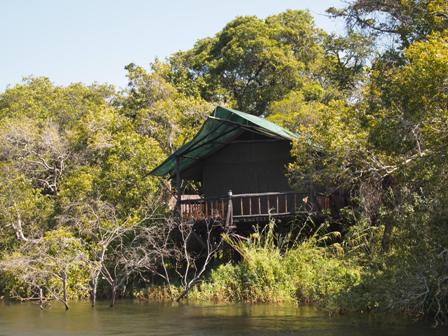
There is also one honeymoon tent, which is more spacious and includes a larger view deck for private dining. Adam told me that they were planning to build a family unit in the next year, possibly renovating a small cabana located near the pool, which would separate this unit from the tents, providing privacy for both. Currently, the child policy is 8 and 9 on request, 10 – 13 are welcome and share with adults at 50% off. Inclusive land and water activities are a guided tour of Victoria Falls (either side), sunset cruise, makoro trip, guided nature trails, cultural tour or nursery school visit, fishing (seasonal and catch and release) and picnic island lunches.
Sussi and Chuma
Located 12km from the Falls, Sussi and Chuma is a Sanctuary Retreat property and consists of twelve chalets on stilts (“Sussi tree-houses”) connected by raised wooden walkways and two private medieval-like stone houses, each with two bedrooms (Chuma Houses). The rounded thatched luxury chalets/tree-houses are built among the canopy of the ebony trees which line the banks of the Zambezi. They are very well appointed with an open plan bathroom (separate toilet) with a bath and shower, AC and and a large private viewing decks facing the river. The two Chuma houses are great for families or couples traveling together. Each has two bedrooms, a cavernous lounge and dining area and a large, private deck and plunge pool that leads to an open lawn fronting the river. Oh and they come with their own private chef and house staff. S&C offer most of the same activities as the other Zambezi lodges but by virtue of their location on the edge of Mosi-oa-Tunya National Park, game drives and walking safaris are also available from the lodge. The park has elephant, impala, giraffe, buffalo, hippo, crocodile, zebra in large numbers and, for the very lucky, white rhino – the only place in Zambia where they can be seen (therefore they are guarded 24/7).
Tongabezi
I really loved Tongabezi. I was only there for a look around and lunch, but what a spectacular and perfectly comfortable place. Even on a manic day of site inspections, there was peacefulness to the lodge. Gary, the manager, was a great host and tour guide. Tongabezi was extensively renovated in 2010 with additional renovation this year as well. The lodge consists of five enclosed river cottages, five very spacious open-air river-fronting “houses” and a Garden House which is perfect for families. Each room includes the service of a personal valet.
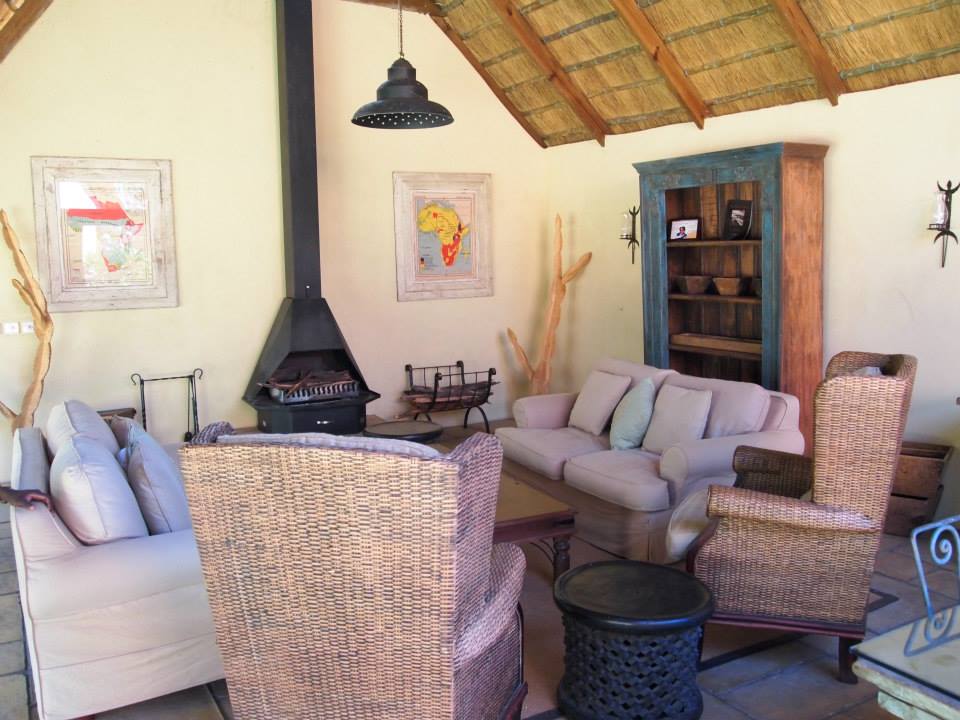
The River Cottages, built in an adobe and thatch style, are fully enclosed with mesh windows. Each has a nice shaded outdoor sitting area and a large stone patio overlooking the Zambezi. These are the lowest priced at Tongabezi and a great option for those uncomfortable with fully open air accommodations but still want to hear the sounds of the bush and the gurgle of the river outside their window. Despite being enclosed, the large number of windows makes for a very bright and warm feel inside.
The five Tongabezi Houses are each individually styled and have unique names to match – the Honeymoon House Bird House, Dog House, Tree House and, yes even the Nut House. They are massive, well-appointed and very comfortable. Each is uniquely decorated and sits directly on or perched just above the river, with beautiful living tree trucks designed into the villas. The Garden House is the family suite at Tongabezi. It is an awesome option for family groups, with two double ensuite bedrooms, private dining room and large lounge, plus private gardens and a plunge pool. It is completely enclosed offering the ultimate private and safe family retreat. It is important to note that it’s the only suite at Tongabezi not located on the river for safety reasons for kids.
Royal Livingstone and Zambezi Sun
My fifth and final stop of the day was at the Sun International duo The Royal Livingstone Hotel and Zambezi Sun Resort. While it’s certainly hard to beat the location nearly on the edge of Victoria Falls, these properties are best for those travelers who are very short on time and access to the Falls is paramount or who simply cannot live without the conventional comforts you’d expect of any major chain hotel, anywhere in the world. While the private entrance to the Falls are easily walkable (Zambezi Sun is closest), this “perfect” location also comes with a price – the never-ending sound of helicopters ferrying gawkers on flightseeing tours over the Falls. All that being said, for a night or two to see the Falls and recover from a long international flight, the location is hard to beat.
The Royal Livingstone does a nice job of recreating a colonial atmosphere and Victorian style, golf carts aside. The grounds are beautiful with a manicured lawn leading down to the Zambezi, the spray of the falls spitting distance away. The public areas of the hotel are lavish, with an elegant sitting area for high tea, bar and formal dining room (note: the expansive and impressive Travelers Bar is open 24 hours a day, however when we visited at around 10pm, it was strangely empty). Rooms are very comfortable with king size beds featuring crisp white sheets, a Victorian styled bathroom with separate bath and shower, private veranda, AC, mini-bar, tea/coffee, writing desk and satellite TV – basically everything you’d expect from a 4 or 5 star hotel. There are 17 colonial-style buildings housing 173 rooms and suites in two-story clusters, with each room facing the Zambezi. The Royal Livingstone Dining Room served an excellent dinner and offers a wonderful Zambian menu in addition to its regular gourmet international fare.
The Zambezi Sun is a very large three-star resort-style hotel that feels very much like a Florida theme park. Its 212 very bright and colorful rooms are centered on a large pool and bar/restaurant area. Large family groups on packaged tours will find this a perfectly wonderful option. And it is only a five minute walk to the Falls!
Zambezi River Lodges, Victoria Falls, Zimbabwe
Victoria Falls Hotel
This being my first trip to Zimbabwe, there really was no other place to start our exploration of the many new and recently refurbished Victoria Falls properties, than the iconic and original Victoria Falls Hotel. We happened to visit on a morning with a number of government dignitaries visits for a mining symposium and lunch – quite a scene of arriving Mercedes and BMWs, that’s for sure! Side note, Zimbabwean police drive Mercedes?!
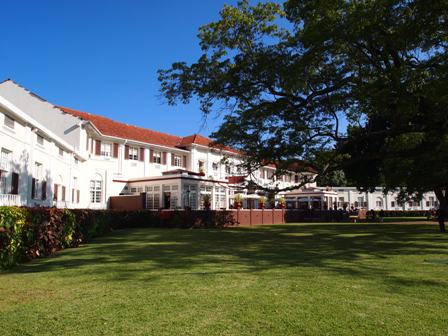
The hotel was built in 1904 as housing for the workers building the Victoria Falls Bridge. But I won’t detail the history of the hotel; grab one of the many books for that. Much of the hotel was under refurbishment or unavailable for viewing. The few rooms we saw were all in the Central Wing and a bit cramped, especially the bathrooms, and slightly dated, though comfortable. Rooms in the Central Wing do have partial views of the Falls spray and the bridge. The Stable Wing, which was being refurbed, has larger rooms that face the gardens or an inner courtyard. There is a beautiful pool area and terrace restaurant for light meals and sundowners, all with spectacular views of the gorge, bridge and the “smoke that thunders.”
Like any hotel near the Falls, helicopters are a constant presence, so prepare your pax for this. For most, it’s probably a non-issue but I find it a bit of a nuisance. I’m probably just being a curmudgeon. The d’cor is grandly colonial, as one would expect, with beautiful arched hallways, many stuffed animal heads, portraits of the Queen and other English dignitaries of that bygone area, and most interesting to me, vintage Africa travel posters from the early part of the 20th century. It’s a classic and good for those pax who are very keen on the history and romance of the colonial era. It’s certainly very convenient to all activities in the Vic Falls area. If pax are staying for a short time and focused on the Falls, then it’s a good choice, if a little price inflated because of the name.
Victoria Falls Safari Lodge
This traditional safari lodge style hotel is located just outside town on a hill overlooking the bush of the Zambezi National Park. The large multi-level wood and thatch main lodge faces west (great sunsets!) overlooking an active waterhole and features a very large viewing deck, restaurant and bar and pool. Felt a bit dark inside but probably nice and cool in the summer time. The 72 rooms are decorated in a generic African motif and have three categories – standard, deluxe and suites ((2 levels) which all have a small deck facing the waterhole. There is a plan to refurb the bathrooms including removing the very large tubs. A good option for groups and families with no minimum age.
Victoria Falls Safari Club
Just next door to the VF Safari Lodge and sharing some facilities, this is a boutique option with 16 spacious standard rooms and four suites which include a connected sitting room. Decorated in a more modern, “safari chic” style, each room faces the bush but currently with no waterhole (Safari Lodge WH is not visible from the Safari Club). There are plans to add a waterhole for the Club in the future and this will be a welcomed addition. The Club has a small main lodge with breakfast buffet and light snacks and bar but lunch and dinner are served next door at the Safari Lodge. The pool is also shared. The rates are on a bed and breakfast basis and include Butler service, complimentary mini-bar, afternoon tea & pastries, evening cocktail & snacks and WiFI.
The third property in the Africa Albida complex is Lokuthula, which has 37 self-catering chalets.
Victoria Falls River Lodge
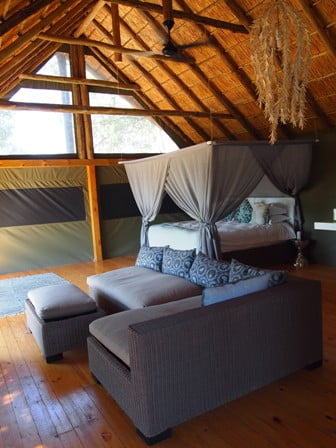
This newly built riverfront property is located around 10K upstream from the Falls is the first private game lodge in the Zambezi National Park. It is accessible by road (tarmac then rough dirt track in the park) but we arrived by boat and this is highly recommended. We encountered a HUGE herd of elephants (30+) along the river and spent about 30 minutes with them before continuing on to the lodge.
The lodge is intimate with eight luxurious and very private tented chalets set along and back from the river. With the canvas walls and thatched roofs on the outside and the Euro-modern d’cor on the inside, the style feels like a hybrid between a traditional African tented camp and a chic hotel in Scandinavia. It’s unique and works for the most part. The front of the tents are fully enclosed with glass sliding doors and mesh screens, allowing for some climate/mosquito control (AC is available) without compromising the sounds of the bush, river and hippos. Each has a large view deck but the chairs provided are of the ultra-modern kind that are all form, no function. Not a real inviting place to enjoy a morning cup of coffee or glass of wine in the evening. There is an outdoor shower and a large bathtub inside behind a mesh screen. All hot water is solar heated. Families will love the three tents which feature an alcove with double bunk bed and a single bed.
The main lodge is designed in an open plan style, set back from the river with excellent bird and wildlife viewing along and in front of the river from the lounge area. There is a small pool and a raised viewing platform near a saltlick offering incredible views of the river and surrounding bush. A great spot for watching the sunrise with a cup of coffee, special romantic dinners or just gazing down at the wildlife enjoying the salt lick.
The food was just okay and the service a little uneven, but chalk that up to growing pains. The manager, George, was an excellent host. He’s a Zimbabwean pro-guide and can regale you with incredible tales from the bush. He leads the walking safaris right from the lodge and he’s one of those guides who can really bring the little things to life. While we didn’t go on a drive, reports are the game is decent with large herds of elephants, hippo, crocodile, buffalo, giraffe, zebra, wildebeest, plains game and the very rare big cat sighting. The river activities are really the focus however and the lodge has a very comfortable pontoon boat for sundowner and safari cruises. They also will arrange a picnic on a private island which is part of their concession. They do offer free transfers to town for Vic Falls activities.
The smaller size and location lends an exclusivity and privacy to this property that is hard if not impossible to match on the Zimbabwe side of the Zambezi. The lodge owners (Zambezi Crescent) have plans to build in Mana Pools and Karibu which when complete, would create a nice safari circuit.
Gorges Lodge
One of three properties owned and managed by Imvelo Safari Lodges, Gorges Lodge is perched on the very edge of Batoka Gorge, 250 breathtaking meters above the Zambezi River (for rafters, it overlooks rapid 19). Located about 25-30 minutes from Vic Falls on a dirt track, Gorges has 10 thatch and stone cottages that sit literally on the precipice of the gorge. Seriously, if you’re afraid of heights, this place might not be for you! It is an absolutely spectacular location and completely unique in the area. The gorge is home to an incredible array of raptors – eagles, falcons and more – that captivate as they effortlessly soar above the gorge looking for prey. The manicured gardens that envelop the cottages and main lodge are lovingly cared for by the staff and offer a lush, verdant oasis from the dry bushveld. There are plans to expand the pool area next to the main lodge, creating a more inviting patio for lounging and a larger pool.
The cottages are a bit dated and basic but comfortable (and a light refresh was planned). This is 3-star accommodation with 5-star location and service from the on-site managers and local staff.
Elephant Camp
Located just 10 minutes outside of Vic Falls on a private concession within the National Park, the Elephant Camp feels like it’s a world away from the hustle and bustle of the busy town. Owned by the tour operator Wild Frontiers, this is a first class luxury tented camp sitting on a rise in the bush with great views back toward the Falls and the Bakota Gorge. I’d describe the style as casual colonial with very relaxed and comfortable feel to the entire place. The 12 well-appointed ensuite tents are set along a pathway through the bush and are very private. Each has a huge deck with private plunge pool with distant views of either the Falls or the Gorge. The suites are all equipped with indoor and outdoor showers, huge baths, private lounges, mini bar and tea/coffee stations, overhead fans plus air conditioning and are all mosquito proofed. The cozy main lodge has an expansive view deck and small pool overlooking a large waterhole and the spray of the Falls.
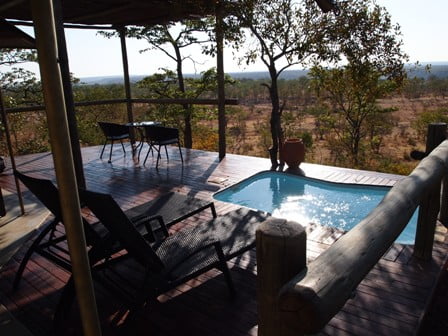
The camp offers an excellent combination of the Vic Falls active and adrenalin adventures with intimate wildlife encounters, including close interaction with the orphaned elephants at the Wild Horizons Wildlife Sanctuary and guided walks with Sylvester the Cheetah Ambassador, a three-year old rescued cheetah. Walks with Sylvester are offered 2x a day in the early morning and late afternoon. The small-groups led by Sylvester and his team from the Sanctuary, head toward the camp waterhole and then to the edge of the gorge. Despite being raised since birth by humans, Sylvester still feels the pull of the wild, having chased down warthogs, impala, wildebeest, and even bringing down a male kudu. But apparently he lacks the killer instinct as Sylvester inevitably becomes the one being chased, tail between his legs, in the end!
I really liked Elephant Camp and I’m not the only one. It was a 2013 finalist in the Best New Safari Camp in Africa category in Good Safari Guide Awards and a Trip Advisor Travelers’ Choice 2013 Winner for Small Luxury Hotels in Africa.
Hwange National Park
Bomani Tented Camp
We spent the next two days exploring the farther reaches of Hwange National Park beginning with the two Imvelo properties in the far southeast edge of the park – Bomani Tented Camp and the brand-new Camelthorn Lodge. Reaching this remote corner of the park takes some effort, at least via road transfer. It’s about 2.5 hours on a tarmac road to Halfway House (between Vic Falls and Bulawayo) and then another hour and a half on a dirt track through the thick Ngamo forest, before reaching Bomani. Because the bush is so thick in this area, seeing game isn’t easy so I wouldn’t really qualify this as a proper game drive. Alternatively, most New Frontiers guests are arriving via air charter to Bomani’s airstrip, just 1K from the camp. It’s a bit more expensive this way but completely worth it given the amount of time saved. Bomani has a wonderfully wild, Out of Africa feel to it. This part of Hwange was once an ancient fossil lake, which was slowly buried by Kalahari sands from the west. Today, the dry, sandy and expansive plains are scattered with natural (and many man-made) water holes, which breathe life into the park and provide sanctuary to the large herds of wildlife that call it home.
Upon arrival, we were met by Imvelo’s energetic and enthusiastic owner Mark Butcher, who welcomed us with a much needed cheeseburger and beer! “Butch” is a former Hwange game ranger and Zimbabwean pro-guide turned safari operator. He is completely passionate about Zimbabwe, his camps, Hwange and the communities that benefit from his safari operations in this remote corner of the park. Having survived the dark times in the early and middle 2000’s, Butch is bullish about the future of the safari industry in Zimbabwe. He’s also cautiously optimistic about a political and economic recovery in the coming years, though this is certainly impossible to predict with Mugabe still firmly entrenched in power.
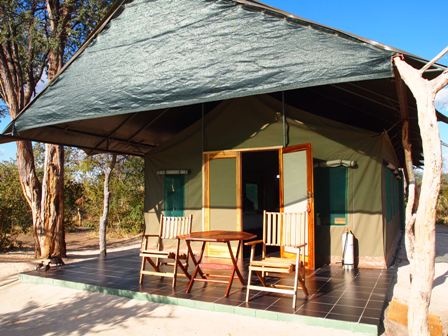
Bomani is a traditional canvas tented camp just outside the Hwange Park boundary which would be perfectly at home in the Serengeti. On one side of the main lodge overlooking a very active waterhole is the four “Spurwing” tents, the newest and largest, each with plenty of room for two twin beds, a comfortable seating area and an ensuite bath with shower (enclosed). Speaking of traditional, the hot water comes from a fire heated boiler, which is heated early in the morning and on request at other times. The tiled verandas with classic canvas safari chairs are a perfect place for early morning coffee or a night cap while watching a sky full of stars. There is one honeymoon tent which has a king size bed and open plan bathroom complete with a claw foot bathtub!
Next to the tents and closest to the lodge, there is one “Royal” suite, a fully-enclosed thatch-roofed bungalow built on-spec for a Qatari Sheik (seriously). It also has AC and satellite TV, because, well, the Sheik wanted to watch soccer (this is a great story – ask Butch). This is often used for families. On the opposite side of the main lodge are the five stilted “Hornbill” tents which look out over the grassy plains and are slightly smaller and a bit dated. A light refresh would really help.
The main wood beam and thatched lodge overlooks the Bomani pan waterhole and has an open dining area, bar and lounge, built on a raised viewing platform. The cuisine isn’t fancy but it’s filling and fresh, using only locally sourced and seasonal ingredients. I’d call it homestyle comfort food. We had a wonderful dinner under the stars of pork chops, stewed veggies and mashed potatoes, while stargazing and listening to the ele’s slurp at the waterhole next to us. It was an amazing dinner, gourmet or not.
We started the following morning with an early morning walking safari, departing on foot from the camp and across the grasslands. Bomani is located on a private concession, just outside the Hwange park boundary. There had been quite a commotion earlier in the morning and we embarked toward the kerfuffle led by Vaughn, our walking guide. The Hwange border in this region is set upon the railroad that connects Vic Falls and Bulawayo. One of the several unique features of Hwange is this rail line, which is still in use, though infrequently and unreliably. Originally there were visions of safari-goers visiting Hwange by rail but this dream died long ago. With the rail bed being raised above the surrounding plains, offers a great viewing platform and from this slightly higher vantage point, we were able to spot the cause of the zebras’ concern – a large pride of lions (8 or more females and a large male) concentrated around a kill. The jackals were converging and making quite a racket themselves. From our location above the plains and several hundred meters away, we were able to see the interaction between the predator and scavenger. The morning light was beautiful and the cats glowed. I only wish I had a better zoom lens!
In the afternoon we visited the newest addition to the Imvelo Safari’s portfolio – Camelthorn Lodge. The lodge was still under construction when we visited though they had just opened one of the forest villas for previewing. It is now open for booking as of September 2013.
Camelthorn Lodge
Camelthorn is nestled among one Hwange’s few remaining native woodlands. Because there is no waterhole in the area, the elephants have left the forest alone and it offers a truly unique safari lodge experience. The most outwardly luxurious of Imvelo’s three properties, the main stone and thatch lodge is U-shaped and wraps around its namesake, a large beautiful Camelthorn tree. It features a mostly open-fronted reception and lounge area and an enclosed dining room with three fireplaces for those chilly winter evenings! The 12 villas (only four are open now, the remaining eight hopefully by mid-2014) are set among the camelthorn and ebony trees. The forest villas have an open plan bedroom with king or two twins and comfy lounge area with fireplace, a separate en-suite bath and large outdoor loft/deck with hammocks for relaxing or a private dinner.
While tucked into the forest, Camelthorn is less than kilometer from the plains and a permanent waterhole with a large, underground blind. This is no ordinary blind which only for the most ardent of photographers will be willing to spend hours squeezed into. Disguised as an anthill, its 6 meters long with an en-suite flush toilet, positioned under the shade of a Leadwood tree to take advantage of evening light and sunsets for incredible elephant, toe-level shots!
Another very unique feature of Hwange and Imvelo’s two lodges is the opportunity to embark on a full-day “pump run” safari. Hwange has very few permanent waterholes due to the Kalahari sands. To keep the population of game from leaving Hwange during the dry season, a series of man-made pumps were installed in the 1920’s to provide year-round water. Today, Imvelo Safaris operate and maintain a string of waterholes along the southern side of the Park during the dry season, April – October. These must be regularly serviced by pump attendants and guests are invited to come along! They pack cooler boxes full of cold drinks and a picnic lunch and embark on a full day game drive slash pump mechanic class! Apparently the elephants are very familiar with the sound of the pumps and when one fires back to life and the water flows, they come a running!
I was very impressed with Mark Butcher and his operation in Hwange. There is clearly a real passion for Hwange, the local community and Zimbabwe as a whole. The location is a bit of a challenge but it’s well worth the flight if pax are willing to pay the cost. While Bomani is by no means dripping with luxurious touches, it has an exclusive feel given the top-notch service and its remote location. Camelthorn looks like a winner, though setting expectations is key given its unique style and woodland location. A combination of three nights each at Camelthorn and Camp Hwange (in the northern part of Hwange – see report below) could be a good one as they are both upmarket and offer two very different types of safari experiences and eco-systems.
Ivory Lodge and Khulu Lodge
We made a short drive-by visit of the Amalinda Collection’s Ivory Lodge and the newly built Khulu Ivory Lodge. Located in a private concession on the eastern edge of the park just outside the main gate, Ivory Lodge is one of the first private lodges built in Hwange. Family-owned and operated, it offers 7 wood and thatch “tree-houses,” which are small and simple but thanks to its perch on stilts, feature great viewing decks of the active waterhole in front of the lodge. One is a larger family suite with two double beds. Recently built and considerably larger are the two Presidential Elephant Suites, finished in a wood and canvas tented style. These are the deluxe option and recommended for FIT bookings. Groups and mid-range families will appreciate the tree-houses. The main thatched lodge is a bit dark but has a great bar and is surrounded by immaculately kept green lawn with a nice boma overlooking a large waterhole which is floodlit at night. There is also a small pool.
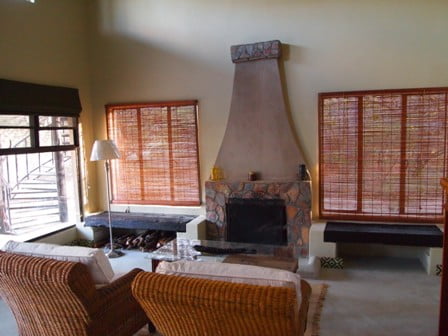
Ivory Khulu was recently opened in July of 2013. While only a five minute drive from Ivory, it is far more exclusive with only six spacious canvas and thatch tents with indoor and outdoor shows and large viewing decks overlooking the waterhole. The main lodge is open air with a contemporary safari style, large viewing deck with plunge pool and raised firepit for evening cocktails under the stars.
With the addition of the newer up-market suites at Ivory and Ivory Khulu, this combines well with Elephant Camp or Victoria Falls River Lodge. Welcoming kids of all ages, Ivory Lodge is also a good family option in combination with Victoria Falls Safari Lodge.
Nehimba Camp
A stylish and contemporary new camp located on a private concession pretty well smack in the middle of the park. Access is via the Hwange Main Gate. There are seven chalets, two of which are configured with four beds for families. There is no minimum age, so this should be a top option for upmarket families. The chalets are of the open plan variety, so privacy could be an issue, especially in the family suites. Some of the outdoor showers weren’t connected to the bath and in general, the chalets felt a little oddly configured to me.
The main lodge overlooks a waterhole but apparently the elephants prefer drinking from the pool! A fence of gnarled downed trees provides some level of protection from the thirsty beasts.
Camp Hwange
The newest kid on the Hwange block, Camp Hwange is a stunning up-market property situated in its own private concession in the lesser-traveled and hillier northern sector of the park. It enjoys the advantage of being one of the closest camps to Vic Falls at only three hours via the Sinamatella gate, with nearly two of those hours being a game drive through the park. The only downside is the incredibly ugly and very depressing mountains of coal from the mines lining the road between Hwange and the park. Flying is also an option, from Victoria Falls to the Sinamatella airstrip (approx 30 mins), leaving a 40K game drive to Camp Hwange through the park.
Owned in part by Zimbabwe Pro-Guide and walking guide extraordinaire Dave Carson, Camp Hwange is rapidly becoming known as one of the best places for walking safaris in Zimbabwe. Zimbabwe pro-guides are widely recognized at some of the greatest in Africa and from my experience, Camp Hwange has hand-picked their guides from the best of the best.
The camp itself is set around a waterhole with eight thatched tented chalets. These are of a good size but without wasted space. They have a stylish simplicity to them, without unnecessary clutter. The chalets are enclosed but have a mesh screens facing the waterhole for great views from the bed and the huge indoor shower. While there is no outdoor shower, with the mesh and the view, it feels like one. Other “comforts” that some may miss – no AC and no WiFi at all (though in an emergency, there is a computer with internet access in the office). Like the chalets, the main lodge has a simple, unpretentious elegance to it. All on one level and eschewing the grand entrances of so many safari lodges, it has an open plan facing the wonderful boma and very large and active waterhole beyond. The lounge’s overstuffed leather couches invite you to flop and relax with a drink and watch the action. The design is funky and chic, with great touches like the woven grass chandeliers and side tables fashioned from traditional drums.
Camp Hwange’s comfortable and unpretentious style makes it the perfect retreat after the thrill and excitement of a walking safari with one of their phenomenal guides. On our visit, we were lucky enough to have two absolutely incredible wildlife encounters on foot. Our guide, Julian, was hand-picked by Dave to help build the camp from the ground up. He spent several months camped beside the waterhole, exploring the bush, learning about the unique landscapes of northern Hwange and intimately getting to know the animals in the area. On our first walk, we approached a large bull elephant. Julian was constantly checking the wind by squeezing a small baby power dispenser. Elephants have an excellent sense of smell but very poor eyesight, so as long as you stay upwind, observing these amazing creatures from a very close distance is possible. And while my heart was certainly pounding as we tip-toed through the bush, closer and closer, with baby power flying the in wind, I always felt that Julian was in complete control and we were safe. It was a thrilling experience.
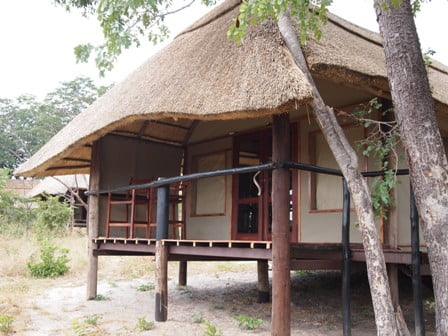
Our second walk was even more exhilarating. And slightly terrifying. We were on our game drive out of the park and made a view stop at one of the self-drive picnic and camping sites atop a rocky outcropping. The self-drivers were all intently looking through their binoculars at the plains below and excitedly talking about the lions they’d heard roaring all night. This was all Julian needed to hear and he immediately signaled for us to discreetly return to the vehicle. We peeled out of the parking area and down the hill in the direction of the lions. My thought at this point was “cool, we’re going to go find the lions in the landy!” Julian had other ideas. At the bottom of the hill, he pulled over, hopped out and grabbed his rifle. “Let’s go find em!” Sure enough, he meant on foot. Lions!? On our drive down from the overlook, Julian had relayed the story of the three lion brothers who roamed this part of the park – Daniel, Day and Lewis – and who he suspected were cause of all the excitement. So named as cubs by Dave Carson for their wild, youthful mohawks reminiscent of the warrior tribe in The Last of the Mohicans, starring, you guessed it, Daniel Day Lewis.
As before, Julian had specific ground rules for this walk. Namely, stay behind him, stop when he stops and never, ever run. In less than a minute on the trail, we came across lion prints in the sand. Up to this point, I was certain there was no way we were going to find these lions. Think again. Winding our way through the sandy grasslands following Julian, when he signaled for us to stop and crouch down. Across the grasslands embraced by a thicket of trees were two of the brothers. Wow, what a moment. This was far different than watching lions from a vehicle or even from atop the railroad bed by Bomani. We were much closer and at their level. I was cognizant of how exposed and how vulnerable we were, a modern human being thrust into a primal world. At first, the two brothers didn’t see us. They were intently stalking something in the opposite direction. But then, their interest waned or they caught a whiff of something foreign in the air and Daniel was looking directly at us. Starring. Evaluating. Intrigued. His tail began to twitch, just like a curious house cat. “Right, they’ve seen us. Don’t move,” urged Julian. My heart was pounding out of my chest, a mix of nerves, fear, wonder and exhilaration. It’s quite a moment when the king of beasts has you in a stare down. One guest was a bit concerned about the situation and Julian decided that we should back up and give the boys a bit more space. No less than three seconds after we stood and began to back away, over my right shoulder came the most terrifying and thrilling sound I have ever experienced – the unmistakable roar of a lion, directed at me. A lion’s roar doesn’t so much hit you as it goes right through you. This was the third brother. There was never a question of fight or flight for me. I nearly jumped into Julian’s arms. I can admit it. Julian immediately put himself between the lion and us and we began to back away. After a few more breathless seconds, another deep guttural growl and three strong steps toward us, I thought this may be it. But the lion stopped. And we continued to back away, giving them space. As Julian kept saying, with every step we took backward, they relaxed more and more. Julian was loving every moment! Watch the video below on this amazing walking safari experience!
As I noted in my report on Camelthorn Lodge, Camp Hwange would make a great combination with Camelthorn Lodge in the southern part of the park. It also works well with Victoria Falls River Lodge or Elephant Camp in Vic Falls, for a complete Vic Falls-Hwange circuit.
I came away from my short adventure impressed and energized by the safari opportunities in Hwange. There are many new high quality camps, with mid-range and lux options for families, honeymooners, adventurers and even chic hipsters. The walking is incredible thanks in large part to the exceptional Zimbabwean pro-guides. Hwange is definitely on the upswing, as is Zimbabwe in general. Now is the time to take advantage of the great value and the lower rates of most properties. Come experience Hwange! Your travelers will not be disappointed.
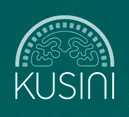


Leave A Comment
You must be logged in to post a comment.